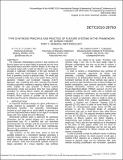| dc.contributor.author | Yu, J. J. | |
| dc.contributor.author | Li, S. Z. | |
| dc.contributor.author | Pei, X. | |
| dc.contributor.author | Su, Hai-jun | |
| dc.contributor.author | Hopkins, Jonathan B | |
| dc.contributor.author | Culpepper, Martin | |
| dc.date.accessioned | 2018-11-15T21:13:16Z | |
| dc.date.available | 2018-11-15T21:13:16Z | |
| dc.date.issued | 2010-08 | |
| dc.identifier.isbn | 978-0-7918-4410-6 | |
| dc.identifier.uri | http://hdl.handle.net/1721.1/119134 | |
| dc.description.abstract | The systematic methodologies involved in type synthesis of flexure systems are no doubt helpful to generate one and more high-performance precision machine designs at the stage of conceptual design with a rapid and effective way. This paper provides a systematic formulation of the type synthesis of parallel, serial, and hybrid flexure systems via a mapping from a geometric concept to physical entity. The whole type synthesis principle is built upon screw system theory and the geometric Freedom and Constraint Topology (FACT) approach, also combining with other concepts and methods including equivalent compliance mapping, building block etc, which enables the type synthesis of flexure systems deterministic, simple and practical. After that, Type synthesis procedure for various flexure systems are elaborated with examples. As a result, as many specified-DOF (Degree of Freedom) flexure systems as possible can be found and therefore pave the way for obtaining an optimal configuration. | en_US |
| dc.description.sponsorship | National Natural Science Foundation (China) (50775007) | en_US |
| dc.description.sponsorship | National Natural Science Foundation (China) (50875008) | en_US |
| dc.description.sponsorship | National Natural Science Foundation (China) (50975007) | en_US |
| dc.description.sponsorship | National Science Foundation (U.S.) (CMMI-0457041) | en_US |
| dc.description.sponsorship | National Science Foundation (U.S.) (DMI-0500272) | en_US |
| dc.description.sponsorship | Beijing Nova Program (2006A13) | en_US |
| dc.description.sponsorship | Beijing Municipal Natural Science Foundation (4092026) | en_US |
| dc.publisher | ASME International | en_US |
| dc.relation.isversionof | http://dx.doi.org/10.1115/DETC2010-28783 | en_US |
| dc.rights | Article is made available in accordance with the publisher's policy and may be subject to US copyright law. Please refer to the publisher's site for terms of use. | en_US |
| dc.source | ASME | en_US |
| dc.title | Type Synthesis Principle and Practice of Flexure Systems in the Framework of Screw Theory: Part I—General Methodology | en_US |
| dc.type | Article | en_US |
| dc.identifier.citation | Yu, J. J., S. Z. Li, X. Pei, Hai-jun Su, J. B. Hopkins, and M. L. Culpepper. “Type Synthesis Principle and Practice of Flexure Systems in the Framework of Screw Theory: Part I—General Methodology.” Volume 2: 34th Annual Mechanisms and Robotics Conference, Parts A and B (2010), Montreal, Quebec, Canada, ACME International, 2010. © 2010 ACME International | en_US |
| dc.contributor.department | Massachusetts Institute of Technology. Department of Mechanical Engineering | en_US |
| dc.contributor.mitauthor | Hopkins, Jonathan B | |
| dc.contributor.mitauthor | Culpepper, Martin | |
| dc.relation.journal | Volume 2: 34th Annual Mechanisms and Robotics Conference, Parts A and B | en_US |
| dc.eprint.version | Final published version | en_US |
| dc.type.uri | http://purl.org/eprint/type/ConferencePaper | en_US |
| eprint.status | http://purl.org/eprint/status/NonPeerReviewed | en_US |
| dc.date.updated | 2018-11-09T14:32:09Z | |
| dspace.orderedauthors | Yu, J. J.; Li, S. Z.; Pei, X.; Su, Hai-jun; Hopkins, J. B.; Culpepper, M. L. | en_US |
| dspace.embargo.terms | N | en_US |
| dc.identifier.orcid | https://orcid.org/0000-0002-8014-1940 | |
| mit.license | PUBLISHER_POLICY | en_US |
